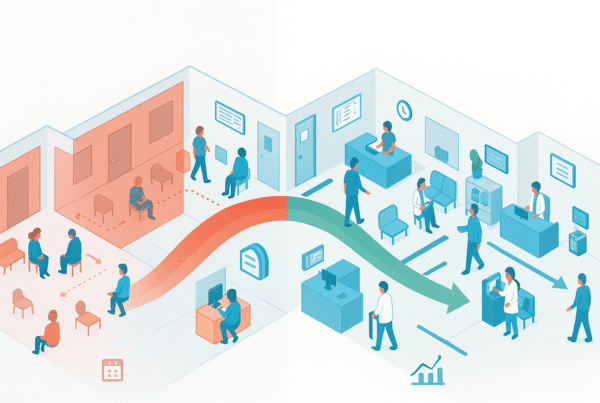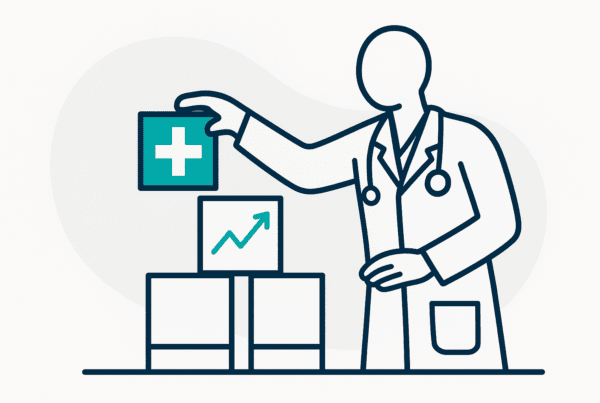Whether you’re considering selling your practice, expanding your operations, or simply trying to avoid costly compliance penalties, you need to understand how Healthcare Interoperability Standards 2025 will affect your practice’s value and daily operations.
Want to see how well your practice implements interoperability? Download our free checklist here.
If you’ve been putting off learning about these standards, thinking they’re just another IT headache, you’re not alone. We work with practice owners every day who initially felt overwhelmed by terms like FHIR (Fast Healthcare Interoperability Resources) and HL7 standards.
But here’s what we’ve learned: the practices that master these standards early gain significant competitive advantages, while those that wait face steeper costs and reduced sale values.
Healthcare data exchange through interoperability isn’t optional anymore. Federal regulations now require it, and penalties for non-compliance can reach $1 million per violation. More importantly for your bottom line, buyers increasingly view strong interoperability capabilities as essential for any practice acquisition.
What Exactly Are Healthcare Interoperability Standards?
Think of healthcare interoperability standards as the universal language that lets your practice’s systems talk to hospitals, labs, pharmacies, and other providers seamlessly.
Just like your smartphone connects to any WiFi network using standard protocols, these standards ensure your patient data flows accurately across different healthcare systems.
When your practice has proper healthcare data exchange capabilities, you can:
- Automatically receive lab results directly into your EHR
- Share patient records instantly during referrals
- Coordinate care without endless phone calls and fax machines
We often use this analogy with practice owners: remember when banks first started offering ATM networks? Initially, you could only use your bank’s ATMs. But once they adopted interoperability standards, you could access your account from any machine anywhere. Healthcare is finally reaching that same level of connectivity.
For your practice, this means:
- Reduced administrative burden
- Fewer medical errors
- Improved patient satisfaction
- Compliance with federal regulations that carry serious financial penalties
Why Should I Care About the 4 Levels of Interoperability?
Understanding these four levels helps you assess where your practice stands today and what investments you might need to make. Think of them as building blocks—each level builds on the previous one.
Level 1: Foundational Interoperability Your systems can exchange data, but they don’t necessarily understand what it means. It’s like receiving a document in a foreign language—you can pass it along, but you can’t act on its contents.
In your practice, this might mean lab results arrive as PDF attachments that your staff must manually enter into patient charts.
Level 2: Structural Interoperability Now your systems understand the format and organization of the data. Lab results automatically populate the correct fields in your EHR, and medication lists transfer between systems with proper dosing information intact.
Level 3: Semantic Interoperability Both systems not only understand the data format but interpret the meaning consistently. This enables automatic clinical decision support across different systems and consistent medication interaction checking regardless of data source.
Level 4: Organizational Interoperability The highest level encompasses the policies, workflows, and legal frameworks that enable effective data sharing between organizations. This includes established data sharing agreements and standardized care coordination processes.
| Interoperability Level | What It Means for Your Practice | Real-World Example |
| Level 1: Foundational | Systems can exchange data but don’t understand meaning | Lab results arrive as PDF attachments requiring manual entry |
| Level 2: Structural | Systems understand data format and organization | Lab values automatically populate correct EHR fields |
| Level 3: Semantic | Systems interpret data meaning consistently | Clinical decision support works across all integrated systems |
| Level 4: Organizational | Full workflow and policy integration | Seamless care coordination with established health system partners |
Most successful practices in 2025 operate at Level 2 or 3. If you’re planning to sell your practice or join a larger health system, Level 4 capabilities become increasingly valuable.
What Are the 4 Pillars That Make Interoperability Actually Work?
Beyond the technical levels, interoperability rests on four pillars that determine whether your practice can effectively participate in coordinated care delivery.
Pillar 1: Technical Standards These are the specifications that define how systems communicate. HL7 standards and FHIR serve as the primary frameworks.
For your practice, this means your EHR vendor should support current FHIR R5 standards, and you should ask about integration costs when systems use common standards.
Pillar 2: Policy and Governance This covers the rules and regulations governing data sharing—the 21st Century Cures Act, HIPAA, and state privacy laws.
You need:
- Proper patient consent management
- Business associate agreements with vendors
- Audit trails for all data access
Pillar 3: Business Processes Your workflows must align with interoperability capabilities. The most sophisticated technology fails without proper process integration.
Successful practices implement:
- Standardized referral workflows that leverage electronic data exchange
- Quality reporting processes that pull data automatically
Pillar 4: Cultural and Social Factors This addresses the human elements—staff training, organizational change management, and patient acceptance.
You need:
- Comprehensive staff training on new features
- Patient education about data sharing benefits
- Change management support during implementations
83.8% of users cite insufficient training as a major barrier to successful adoption. We’ve observed that practices focusing only on the technology while ignoring the process and cultural pillars often struggle with adoption and fail to see the benefits of their investments.
What’s the Difference Between HL7 and FHIR Standards?
HL7 standards represent the most widely adopted framework for healthcare data exchange, but different versions serve different purposes in your practice operations.
HL7 Version 2 (V2): Your Current Workhorse HL7 V2 handles most healthcare messaging, especially hospital-based transactions. If you regularly receive lab results, admit patients to hospitals, or participate in health information exchanges, you’re already using HL7 V2.
This includes:
- Laboratory result delivery
- Admission and discharge notifications
- Prescription management
FHIR: The Modern Standard You Need to Know FHIR (Fast Healthcare Interoperability Resources) represents the evolution of healthcare data exchange, designed for today’s web-based applications and mobile platforms.
Think of FHIR as the iPhone of healthcare standards—intuitive, powerful, and designed for our connected world.
FEDERAL REQUIREMENT
FHIR R5, the current standard in 2025, is mandatory for certified health IT systems. Federal regulations require patient data access APIs, and non-compliance can result in penalties up to $1 million per violation.
FHIR R5 enables:
- Real-time patient data access through smartphone apps
- Seamless integration with wearable devices
- Simplified third-party application integration
- Enhanced patient engagement through consumer-friendly interfaces
What FHIR Compliance Means for Your Practice:
- Meeting federal requirements for patient data access APIs
- Attracting tech-savvy patients who expect modern digital experiences
- Positioning your practice for integration with innovative health technologies
- Reducing long-term integration costs
Key Questions to Ask Your EHR Vendor:
- Does our system support current FHIR R5 standards?
- What interoperability features are included versus additional-cost modules?
- How do you handle integration with our local labs, hospitals, and pharmacies?
How Does Healthcare Data Exchange Affect My Daily Operations?
Understanding how healthcare data exchange works in practice helps you recognize opportunities and challenges in your current operations.
Your Incoming Data Streams
Modern labs can deliver results directly into designated EHR fields, eliminating manual entry and reducing errors.
Specialist reports and consultation notes can flow automatically into patient records when both practices use interoperable systems.
Hospital discharge summaries arrive within hours rather than days when you have effective interoperability.
Your Outgoing Data Obligations
Federal regulations require you to provide patients with immediate electronic access to their health information through patient portals.
When other providers request patient information for treatment, you must provide it without unreasonable barriers or excessive fees.
Many quality programs require electronic submission of clinical data.
COSTS OF POOR INTEROPERABILITY
We regularly see practices where:
- Medical assistants spend 30+ minutes daily manually entering lab results
- Physicians make decisions without complete medication histories
- Front desk staff field constant calls requesting records transfers
One primary care practice calculated they were spending $50,000 annually on staff time for manual data entry that could be eliminated—a hidden cost that buyers definitely notice during due diligence.
What Poor Interoperability Actually Costs You
The real impact shows up in:
- Reduced staff productivity
- Increased error rates
- Patient dissatisfaction
- Administrative overhead
- Hidden costs that affect your practice valuation
How Will This Affect My Practice Value When I Sell?
When potential buyers evaluate your practice, interoperability capabilities significantly influence their assessment of operational efficiency, growth potential, and integration costs.
What Buyers Actually Look For
Buyers prefer practices with EHR systems that integrate seamlessly with their existing infrastructure. Compatibility reduces transition costs and minimizes disruption.
They want well-structured, complete electronic records that enable immediate operational analysis and easier quality reporting integration.
Demonstrated compliance with interoperability regulations reduces buyer risk, while active participation in regional health information exchanges indicates operational sophistication and established care coordination relationships.
75% of healthcare executives view data interoperability as a top priority, and over 50% of top health systems are planning 5-20% spending increases on interoperability solutions. Your readiness directly impacts their interest level.
The Real Valuation Impact
| Value Drivers (Increase Offers) | Value Detractors (Decrease Offers) |
| Modern EHR with FHIR R5 support: +5-10% practice value | Legacy systems needing replacement: -$100K-$500K |
| Documented interoperability compliance: Eliminates buyer risk | Poor data quality/incomplete records: Deal delays |
| Patient portal adoption >70%: Strong engagement indicator | Manual processes requiring automation: Operational inefficiency flag |
| Active HIE participation: Operational sophistication | Compliance gaps: Penalty exposure risk |
| Electronic referral networks: Growth potential | Excessive interface fees: Hidden operational costs |
What Happens During Due Diligence
IT consultants will review your EHR system and data quality to identify immediate needs.
Legal teams verify your adherence to interoperability regulations and assess potential penalty exposure.
Practice management consultants evaluate workflow efficiency and identify automation opportunities that affect their staffing projections.
What Steps Should I Take Right Now?
If your practice needs to improve its interoperability capabilities, here’s a structured approach that minimizes disruption while ensuring compliance and operational benefits.
Phase 1: Assessment and Planning (Months 1-2) Start by inventorying your existing systems and their interoperability capabilities. Document current data sharing workflows and identify pain points. Review compliance with current federal requirements and assess staff training needs.
Next, involve your clinical staff in identifying workflow improvement opportunities. Talk with your EHR vendor about available interoperability features. Connect with key referral partners about their capabilities.
Phase 2: Technical Implementation (Months 2-6) Implement required EHR updates or replacements. Configure patient portal features and access controls. Establish connections with labs, hospitals, and key referral partners. Test data exchange capabilities with major health information exchanges.
Ensure patient API access meets federal requirements. Update business associate agreements with technology vendors. Implement audit trail capabilities and review privacy policies.
Immediate actions you can take today:
- Schedule a comprehensive assessment with your EHR vendor
- Review your compliance status regarding federal requirements
- Calculate hidden costs of current manual processes
- Engage with key referral partners about their capabilities
Phase 3: Workflow Integration (Months 4-8) Train staff on new interoperability features and workflows. Implement standardized referral and care coordination processes. Establish quality reporting procedures that leverage electronic data. Create patient education materials about new digital health capabilities.
Track key metrics like data exchange volume, error rates, and staff productivity. Monitor patient adoption of portal features and gather feedback to identify improvement opportunities.
If You’re Planning to Sell If you’re considering a practice sale in the next 2-3 years, addressing interoperability gaps now can significantly improve your practice’s attractiveness to buyers and support premium valuations. Learn more about maximizing your practice valuation before selling.
Should I Wait or Act Now?
The healthcare industry’s digital transformation continues accelerating, and interoperability standards serve as the foundation for this evolution.
Practices that view these standards as strategic investments rather than compliance burdens will thrive in an increasingly connected healthcare ecosystem.
We often tell practice owners that the question isn’t whether to invest in interoperability—it’s whether to lead the transformation or be forced to catch up later at higher cost with fewer strategic options.
Just as practices that embraced electronic health records early gained competitive advantages, those that master interoperability in 2025 position themselves for continued success.
The transformation may seem daunting, but remember that this represents an investment in your practice’s future operational efficiency, compliance posture, and market value.
Healthcare Interoperability Standards in 2025 aren’t just about compliance—they’re about positioning your practice for success. Whether you’re planning for growth, preparing for a potential sale, or simply want to improve operations, acting now gives you the strategic advantage.
Ready to assess your practice’s interoperability readiness? Whether you’re planning for growth strategies, preparing for a potential sale, or simply want to ensure compliance while improving operations, our M&A advisory team is here to help you navigate these complex decisions with confidence.
For more insights on healthcare practice management and M&A considerations, contact SovDoc’s advisory team or explore our other resources for practice owners navigating today’s evolving healthcare landscape.



